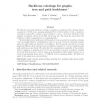Free Online Productivity Tools
i2Speak
i2Symbol
i2OCR
iTex2Img
iWeb2Print
iWeb2Shot
i2Type
iPdf2Split
iPdf2Merge
i2Bopomofo
i2Arabic
i2Style
i2Image
i2PDF
iLatex2Rtf
Sci2ools
JGT
2007
2007
Backbone colorings for graphs: Tree and path backbones
We introduce and study backbone colorings, a variation on classical vertex colorings: Given a graph G = (V, E) and a spanning subgraph H of G (the backbone of G), a backbone coloring for G and H is a proper vertex coloring V → {1, 2, . . .} of G in which the colors assigned to adjacent vertices in H differ by at least two. We study the cases where the backbone is either a spanning tree or a spanning path. We show that for tree backbones of G the number of colors needed for a backbone coloring of G can roughly differ by a multiplicative factor of at most 2 from the chromatic number χ(G); for path backbones this factor is roughly 3 2 . For the special case that G is a split graph the difference from χ(G) is at most an additive constant 2 or 1, for tree backbones and path backbones, respectively. We show that the computational complexity of the problem ‘Given a graph G, a spanning tree T of G, and an integer , is there a backbone coloring for G and T with at most colors?’ jump...
| Added | 15 Dec 2010 |
| Updated | 15 Dec 2010 |
| Type | Journal |
| Year | 2007 |
| Where | JGT |
| Authors | Hajo Broersma, Fedor V. Fomin, Petr A. Golovach, Gerhard J. Woeginger |
Comments (0)

